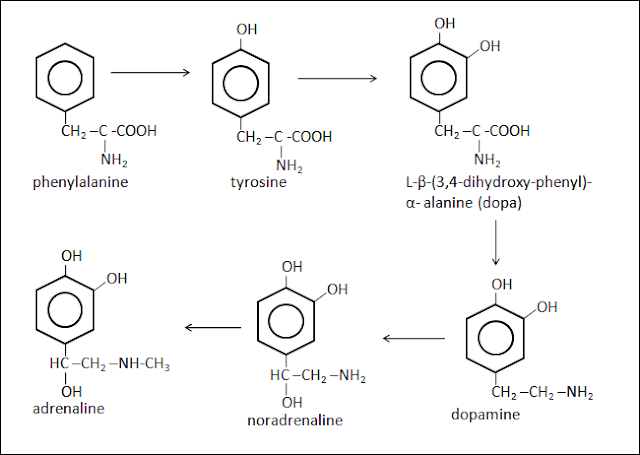HISTORY OF ADRENALINE
In 1895 : polish physiologist napoleon cybulski
was firstly extracts adrenaline from adrenal gland.
In 1857-1938 : john Jacob abel discovered a
naturally synthesized adrenaline from adrenal gland and they gives name
epinephrine.
In 1901 : jokichi takamine isolate the adrenalin hormone from adrenal
glands of animals(sheep, bull or oxen.)
In 1904 : firstly synthesized in laboratory by
friedrich stolz and henry drysdale dakin independently.
ABOUT ADRENALINE
Adrenaline is a medicinal drug
and also natural hormone which produced by the adrenal glands.
Adrenaline is play important role
in a fight-or-flight response.
What is fight-or-flight response
? scroll down the page the point is what is
fight-or-flight response.
CHEMICAL
PROERTIES
IUPAC
NAME : 4-[1 hydroxy -2(methylamino)ethyl ] benzene 1-2-diol.
STRUCTURAL
FORMULA :
PHYSICAL
PROPERTIES
MOLECULAR FORMULA : C9 H13 NO3
MOLECULAR WEIGHT : 183.20 gm/mole
MALTING POINT : 211.5OC
to 212OC.
BOILING POINT : 413.1oC.
SOLUBILITY : adrenaline is
soluble in aqueous solutions of acid salt and also NAOH ,KOH .
Somewhat soluble in water and
alcohol .
Adrenaline is insoluble in ether
,acetone , aqueous solution of ammonia and also insoluble in chloroform.
COLOR : white or colorless some
times is different in color according to their weight.
STATE : micro crystalline powder
. or we can say granule form.
ODOR : odorless.
SYNTHESIS OF ADRENALINE
Here we have a two method for
prepare adrenaline
Method 1 : preparation of adrenaline in
laboratory.
STATEMENT : the reaction of catecol with chloro acetyl
chloride yields substituted compound after that their reaction with an. AlCl3
, CS2 and specific heat gives further compound their reaction with
–NH-CH3 yields –NH-CH3 substituted compound reduction of
these particular substance gives racemic mixture of adrenaline . (±adrenaline).
What is racemic mixture ? : a mixture of equal amounts of of the two
anantiomers (optically active compound) which can not rotate plane polarized
light due to the mutual cancellatio.
METHOD 2 : bio synthesis of adrenaline
STATEMENT : in a adrenal medulla of adrenal gland
medulla oblongata and some neurons produces a adrenaline . in a synthetic
reaction the amino acid convert into the phenylalanine and tyrosine after that
further reaction will step to step produces some intermediates like dopa ,
dopamine , noradrenaline and further process yields adrenaline.
USES
OF ADRENALINE :
Adrenaline is used for a number
of conditions including anaphylaxis ,
cardiac arrest , superficial bleeding.
Adrenaline is also used for
asthma when other treatment are not effective.
How
to induct adrenaline in body : adrenaline is given intravenously (નસ માં) by injection in to a muscle, or other way
by inhalation (શ્વાસ લેવા ની
ક્રિયા ) , or by injection just under the skin.
symptoms of produced
adrenaline in body or adrenaline rush.
faster heard beat.
fast breathing.
also increased in strength and performance of our body.
extreme sweating.
high blood pressure.
side effects of
adrenaline
large amount of adrenaline some time gives side effects
that given bellow.
Disconcertment
in breathing , vomiting and sweating.
Headache
and dizziness some times occur.
Irregular
heartbeat, chest pain , nervousness.
How to control
adrenaline
Do exercise regularly it helps you to control your own
feelings and developed your good health.
General
information
What is
fight-or-flight response ?: fight-or-flight is the physiological reaction
or response of our body that prepare our body to fight with perceived harmful
situation , stressful condition , or risk for survival.
Adrenaline rush
or understanding of physical activity of adrenaline
When you see the dangerous or stressful situation at that time the
information you received is sent form of signels into the almond-shaped
structure of brain known as amygdala.
Once a signels are received by the amygdala it sends signals to other
region of brain known hypothalamus.
As well we know that the adrenal gland is controlled by the hypothalamus;
so hypothalamus regulate the adrenal gland and sends a signals to the adrenal
gland through the autonomic nerves to the adrenal medulla.
When the adrenal gland receive signals , they releases the hormone
adrenaline into the blood.
After that the adrenaline is released in blood it react on the lever cells
and break a larger molecule of glycogen and convert in to small molecule of
glucose; further the glucose is used for gain energy , at that time some
notable activities are we can seen in our body like fast breathing , rapid
heartbeat , sweating , increasing in strength for fight with any situation.
Adrenal
gland[supra renal gland ]
LOCATION : adrenal gland is
located at the anterior end of both kidneys.
Adrenal gland is a paired gland .it is yellowish or brownish in colour.
Structure :
The adrenal glands are divided into two parts :outer layer (adrenal cortex)
and inner layer ( adrenal medulla ). The inner glands (adrenal medulla )
produces adrenaline ; not only adrenaline but it also produces many hormones
including , aldosterone , noradrenaline , and cortisol .
The cortex is vertically striated and yellow coloured , while medulla is
soft, highly vascular and dark brown in color.
Adrenal cortex is divided into four zones : (1) zona glomerulosa (2) zona fasciculate (3) zona reticularis and
(4) x-zone.
Adrenal medulla : adrenal
medulla is a layer inside the adrenal gland which is in a center of an adrenal
gland.
Adrenal medulla contains elastic fibres and large blood spaces (capaleries).
Medulla cells have granular cytoplasm.
see also
ATENOLOL [TENORMIN] - medicinal drug [click here]
orange-II dye or 2-naphthol orange or β-NAPHTHOL ORANGE - mono-azo acidic dye, or basic orange-2 [click here].
crsodine - G or (2,4-diamino-azobenzene) or mono-azo- basic dye [click here].
what is science ? all about science. [click here].
auramine-o or yellow dye or diarylmethane dye or bis [4-(dimethyl amine ) phenyl ] – methanimium chloride. [click here]
[અસ્તુ:]










![ATENOLOL [TENORMIN] - medicinal drug -study everything.](https://blogger.googleusercontent.com/img/b/R29vZ2xl/AVvXsEgGTsBGKNaP_tE51nfYj2h3fKdZpO02gO5BeGfItb45xXsb4Gs_pu7ojGb8kc5WTo3e8qZHTxUwGLRwVrpBxzY-Bld1uR2rsmHRYEj3fX0uV4dEYiMa_46l17eSkXpgPnWb3pgGvDGvkqBU/w100/structural+formula+atenolol.PNG)

0 Comments
please do not enter any spam link in the comment box.